Abstract
Some viruses, such as rubella and human cytomegalovirus, are known to cross the placental barrier and infect the fetus. In other cases of maternal viral infections, such as herpes simplex, evidence for transplacental passage is less convincing and fetal damage or neonatal disease may be coincidental or associated with perinatal infection. Certain cases of fetal or neonatal disease following maternal viral infections may be associated with disease in the mother which affects her metabolic processes or the placenta in such a way as to interfere with development of the fetus and infant.
The possible effects of transplacental viral infections are several. Fetal loss may occur by means of abortion or stillbirth. There may be infection of the fetus, with clinical manifestations such as rash, or without clinical manifestations. The infant may be born with congenital defects, including such deformities as cataracts, cardiac anomalies, mental retardation or cerebral palsy.
Although a number of maternal viral diseases have been etiologically incriminated in congenital defects, only two—rubella and cytomegalovirus infection—are definitely proved to be associated with anomalies or mental retardation in infants.
Full text
PDF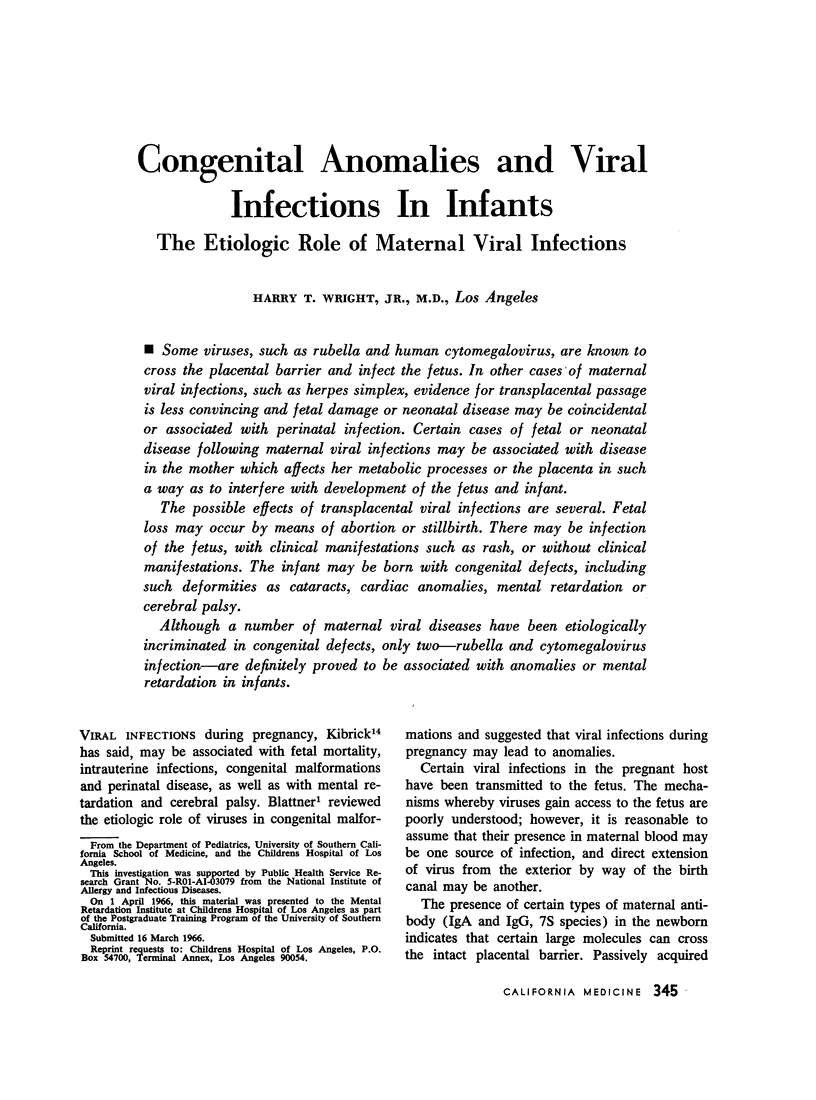
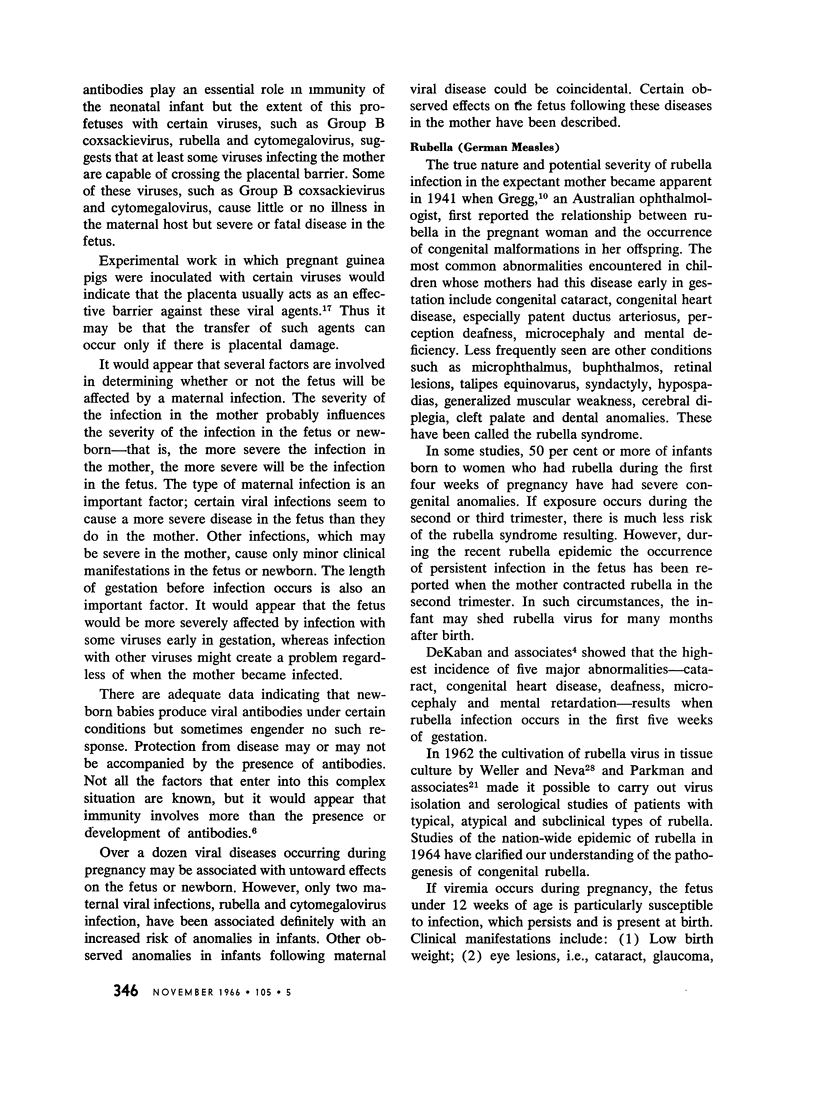
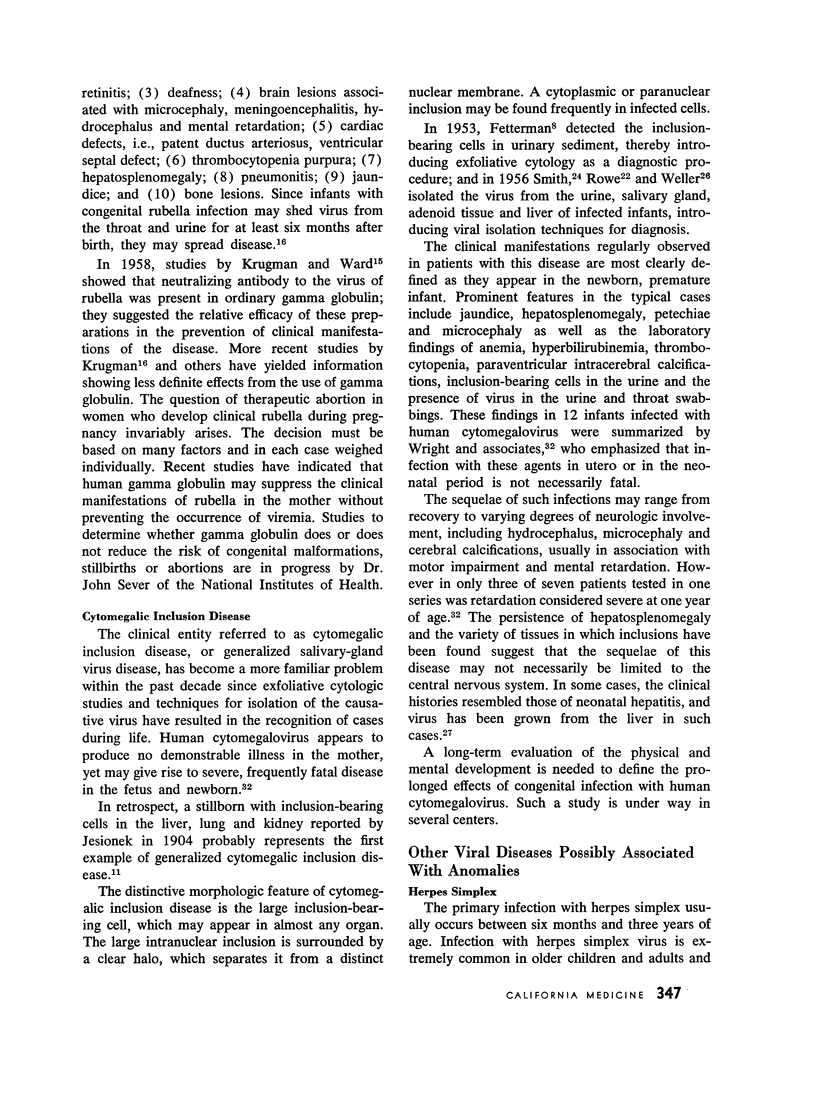
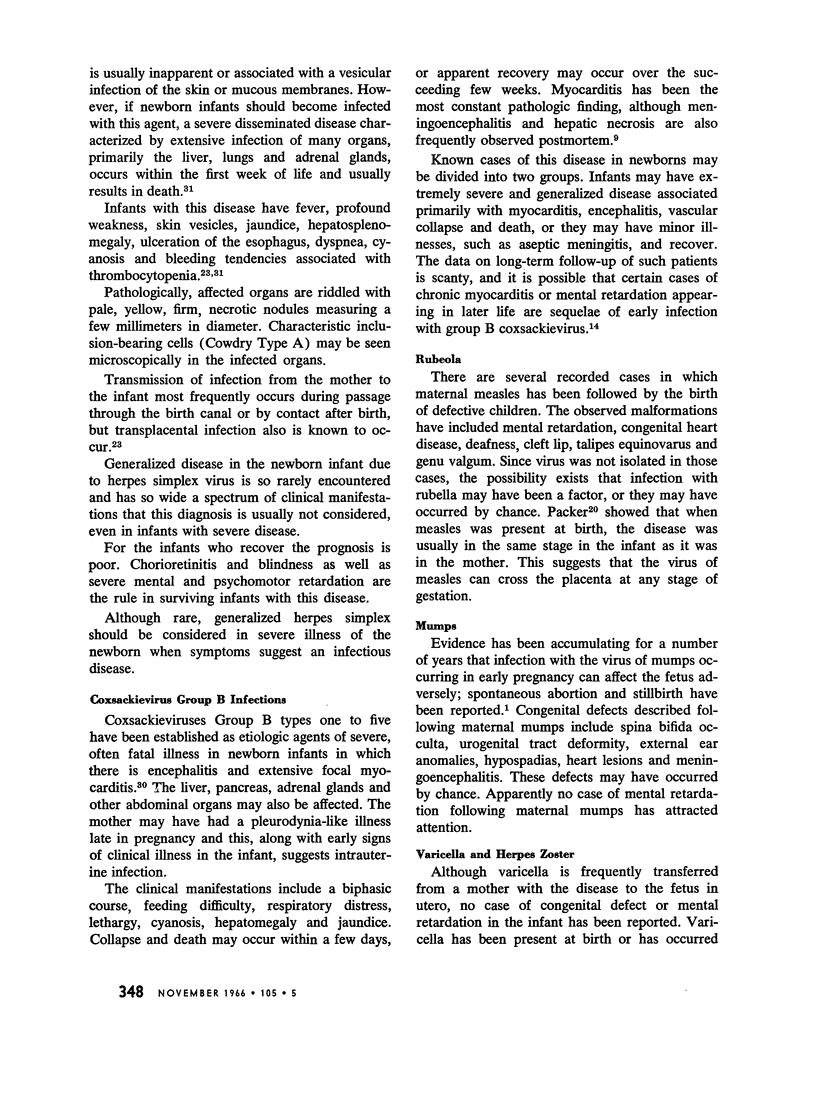
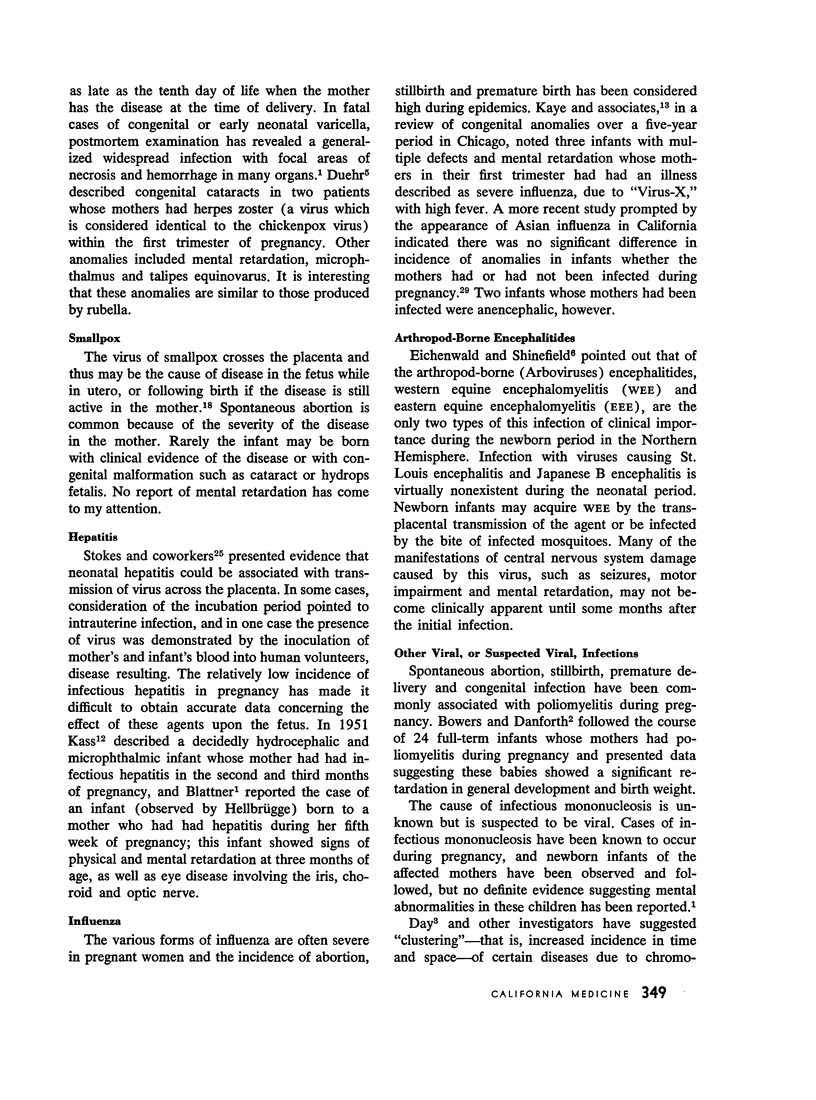
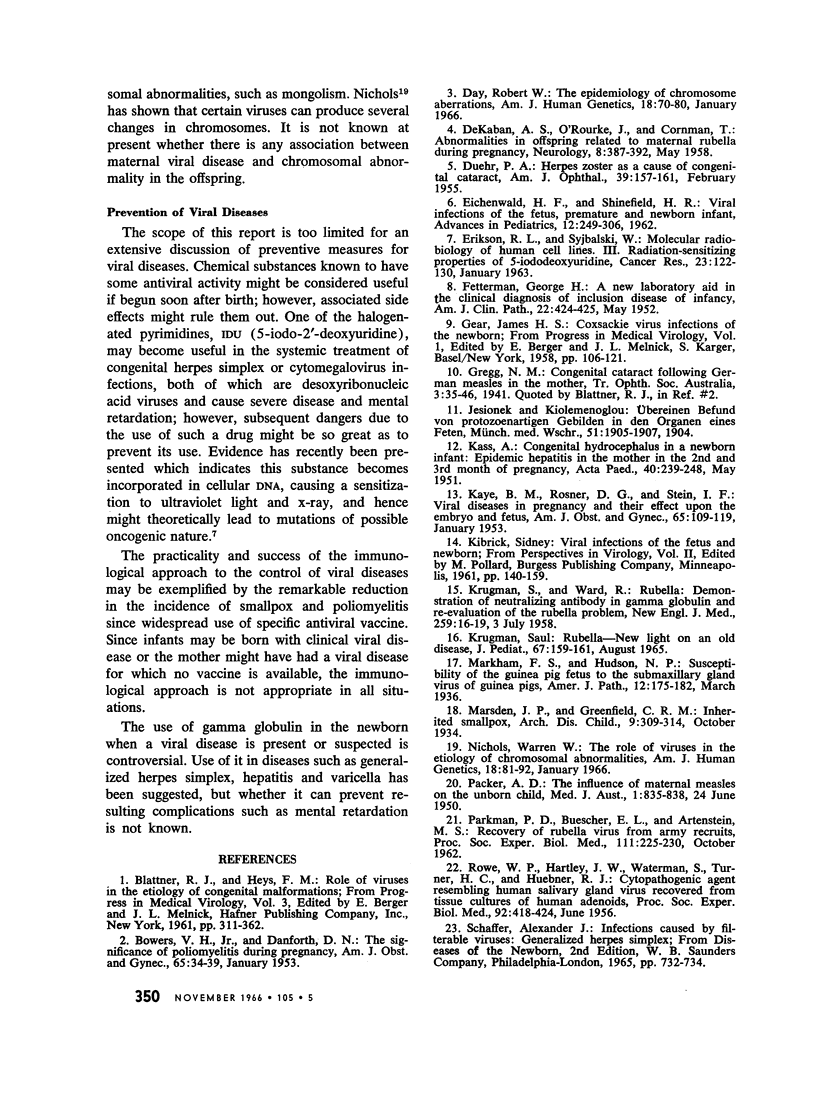
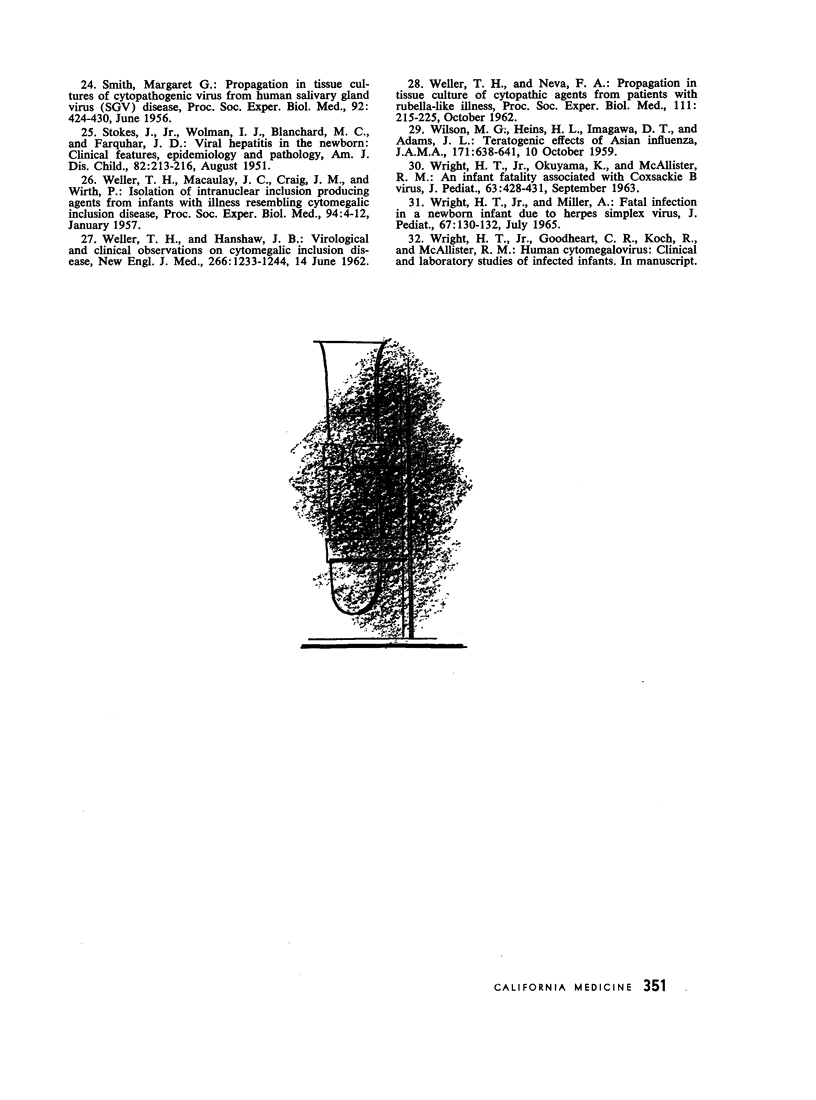
Selected References
These references are in PubMed. This may not be the complete list of references from this article.
- BOWERS V. M., Jr, DANFORTH D. N. The significance of poliomyelitis during pregnancy; an analysis of the literature and presentation of twenty-four new cases. Am J Obstet Gynecol. 1953 Jan;65(1):34–39. doi: 10.1016/0002-9378(53)90007-6. [DOI] [PubMed] [Google Scholar]
- CRAIG J. M., MACAULEY J. C., WELLER T. H., WIRTH P. Isolation of intranuclear inclusion producing agents from infants with illnesses resembling cytomegalic inclusion disease. Proc Soc Exp Biol Med. 1957 Jan;94(1):4–12. doi: 10.3181/00379727-94-22841. [DOI] [PubMed] [Google Scholar]
- DEKABAN A., O'ROURKE J., CORNMAN T. Abnormalities in offspring related to maternal rubella during pregnancy. Neurology. 1958 May;8(5):387–392. doi: 10.1212/wnl.8.5.387. [DOI] [PubMed] [Google Scholar]
- DUEHR P. A. Herpes zoster as a cause of congenital cataract. Am J Ophthalmol. 1955 Feb;39(2 Pt 1):157–161. doi: 10.1016/0002-9394(55)92518-6. [DOI] [PubMed] [Google Scholar]
- Day R. W. The epidemiology of chromosome aberrations. Am J Hum Genet. 1966 Jan;18(1):70–80. [PMC free article] [PubMed] [Google Scholar]
- EICHENWALD H. F., SHINEFIELD H. R. Viral infections of the fetus and of the premature and newborn infant. Adv Pediatr. 1962;12:249–305. [PubMed] [Google Scholar]
- FETTERMAN G. H. A new laboratory aid in the clinical diagnosis of inclusion disease of infancy. Am J Clin Pathol. 1952 May;22(5):424–425. doi: 10.1093/ajcp/22.5.424. [DOI] [PubMed] [Google Scholar]
- GEAR J. H. Coxsackie virus infections of the newborn. Prog Med Virol. 1958;1:106–121. [PubMed] [Google Scholar]
- KASS A. Congenital hydrocephalus in a newborn infant; epidemic hepatitis in the mother in the second-third month of pregnancy. Acta Paediatr. 1951 May;40(3):239–248. doi: 10.1111/j.1651-2227.1951.tb16501.x. [DOI] [PubMed] [Google Scholar]
- KAYE B. M., ROSNER D. C., STEIN I. F. Viral diseases in pregnancy and their effect upon the embryo and fetus. Am J Obstet Gynecol. 1953 Jan;65(1):109–119. doi: 10.1016/0002-9378(53)90018-0. [DOI] [PubMed] [Google Scholar]
- KRUGMAN S., WARD R. Rubella: demonstration of neutralizing antibody in gamma globulin and re-evaluation of the rubella problem. N Engl J Med. 1958 Jul 3;259(1):16–19. doi: 10.1056/NEJM195807032590104. [DOI] [PubMed] [Google Scholar]
- Markham F. S., Hudson N. P. Susceptibility of the Guinea Pig Fetus to the Submaxillary Gland Virus of Guinea Pigs. Am J Pathol. 1936 Mar;12(2):175–182.1. [PMC free article] [PubMed] [Google Scholar]
- Nichols W. W. The role of viruses in the etiology of chromosomal abnormalities. Am J Hum Genet. 1966 Jan;18(1):81–92. [PMC free article] [PubMed] [Google Scholar]
- PACKER A. D. The influence of maternal measles (morbilli) on the unborn child. Med J Aust. 1950 Jun 24;1(25):835–838. doi: 10.5694/j.1326-5377.1950.tb80791.x. [DOI] [PubMed] [Google Scholar]
- PARKMAN P. D., BUESCHER E. L., ARTENSTEIN M. S. Recovery of rubella virus from army recruits. Proc Soc Exp Biol Med. 1962 Oct;111:225–230. doi: 10.3181/00379727-111-27750. [DOI] [PubMed] [Google Scholar]
- ROWE W. P., HARTLEY J. W., WATERMAN S., TURNER H. C., HUEBNER R. J. Cytopathogenic agent resembling human salivary gland virus recovered from tissue cultures of human adenoids. Proc Soc Exp Biol Med. 1956 Jun;92(2):418–424. [PubMed] [Google Scholar]
- STOKES J., Jr, WOLMAN I. J., BLANCHARD M. C., FARQUHAR J. D. Viral hepatitis in the newborn; clinical features, epidemiology, and pathology. AMA Am J Dis Child. 1951 Aug;82(2):213–216. [PubMed] [Google Scholar]
- WELLER T. H., HANSHAW J. B. Virologic and clinical observations on cytomegalic inclusion disease. N Engl J Med. 1962 Jun 14;266:1233–1244. doi: 10.1056/NEJM196206142662401. [DOI] [PubMed] [Google Scholar]
- WILSON M. G., HEINS H. L., IMAGAWA D. T., ADAMS J. M. Teratogenic effects of Asian influenza. J Am Med Assoc. 1959 Oct 10;171:638–641. doi: 10.1001/jama.1959.03010240006003. [DOI] [PubMed] [Google Scholar]
- WRIGHT H. T., Jr, MILLER A. FATAL INFECTION IN A NEWBORN INFANT DUE TO HERPES SIMPLEX VIRUS; REPORT OF A CASE DIAGNOSED BEFORE DEATH. J Pediatr. 1965 Jul;67:130–132. doi: 10.1016/s0022-3476(65)80315-8. [DOI] [PubMed] [Google Scholar]
- WRIGHT H. T., Jr, OKUYAMA K., MCALLISTER R. M. AN INFANT FATALITY ASSOCIATED WITH COXSACKIE B1 VIRUS. J Pediatr. 1963 Sep;63:428–431. doi: 10.1016/s0022-3476(63)80431-x. [DOI] [PubMed] [Google Scholar]


